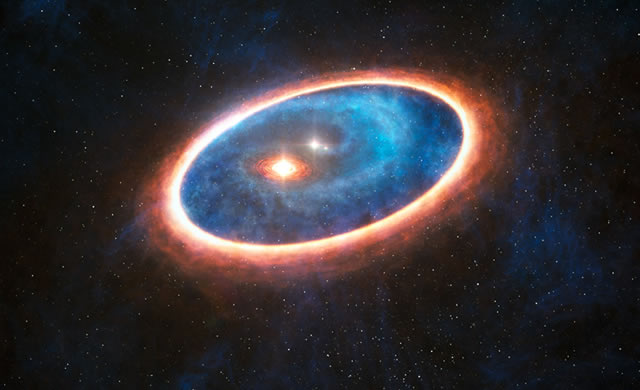
Credit: ESO/L. Calçada
ALMA osserva gas e polvere in “ruote concentriche” come nel carro di Ezechiele – Per la prima volta, alcuni ricercatori hanno rivelato, con ALMA, un flusso di gas da un disco esterno massiccio verso le regioni più interne di un sistema binario. Questa struttura mai vista prima potrebbe essere responsabile del sostentamento di un secondo disco, più piccolo, del materiale necessario per formare pianeti, disco che avrebbe dovuto altrimenti sparire già da molto tempo. Metà delle stelle simili al Sole nascono in sistemi binari e perciò questi risultati avranno importanti conseguenze sulla ricerca degli esopianeti. l risultati sono stati pubblicati dalla rivista Nature il 30 ottobre 2014.
Un gruppo di ricerca guidato da Anne Dutrey, del Laboratory of Astrophysics di Bordeau, Francia e del CNRS hanno usato ALMA (Atacama Large Millimeter/submillimeter Array) per osservare la distribuzione della polvere e del gas in un sistema multiplo di stelle noto come GG Tau-A. Questo oggetto ha solo pochi milioni di anni e si trova a circa 450 anni luce dalla Terra, nella costellazione del Toro. Come una “ruota nella ruota”, GG Tau-A contiene un grande disco esterno che circonda l’intero sistema e un disco interno che circonda la stella principale al centro. Il disco interno ha una massa pari circa a quella di Giove. La sua presenza è stata un mistero stimolante per gli astronomi poichè il tasso di perdita di materia, che finisce sulla stella centrale, avrebbe dovuto esaurirlo già da tempo. Osservando queste strutture con ALMA, l’equipe ha fatto l’emozionante scoperta di grumi di gas nella regione tra i due dischi. Le nuove osservazioni suggeriscono che il materiale si sta trasferendo dal disco esterno a quello interno, creando un canale di rifornimento tra i due. “Il materiale che fluisce attraverso la cavità era stato previsto da simulazioni numeriche, ma non era mai stato osservato prima. Rivelare questi grumi indica che la materia si sta muovendo nello spazio tra i due dischi, permettendo all’uno di nutrire l’altro”, spiega Dutrey. “Queste osservazioni dimostrano che la materia dal disco esterno può sostenere l’esistenza del disco interno per un lungo periodo. Questo ha delle conseguenze importanti per la potenziale formazione di pianeti”.
I pianeti nascono dal materiale rimasto dopo la nascita della stella.
Si tratta di un processo lento, che richiede la presenza di un disco di lunga durata. Se il processo di alimentazione del disco interno ora osservato con ALMA avviene in altri sistemi multipli di stelle, si apre la possibilità di un grande numero di luoghi potenziali per trovare esopianeti in futuro.
For the first time, researchers using ALMA have detected a streamer of gas flowing from a massive outer disc toward the inner reaches of a binary star system. This never-before-seen feature may be responsible for sustaining a second, smaller disc of planet-forming material that otherwise would have disappeared long ago. Half of Sun-like stars are born in binary systems, meaning that these findings will have major consequences for the hunt for exoplanets. The results are published in the journal Nature on 30 October 2014.
A research group led by Anne Dutrey from the Laboratory of Astrophysics of Bordeaux, France and CNRS used the Atacama Large Millimeter/submillimeter Array (ALMA) to observe the distribution of dust and gas in a multiple-star system called GG Tau-A. This object is only a few million years old and lies about 450 light-years from Earth in the constellation of Taurus (The Bull). Like a wheel in a wheel, GG Tau-A contains a large, outer disc encircling the entire system as well as an inner disc around the main central star. This second inner disc has a mass roughly equivalent to that of Jupiter. Its presence has been an intriguing mystery for astronomers since it is losing material to its central star at a rate that should have depleted it long ago. While observing these structures with ALMA, the team made the exciting discovery of gas clumps in the region between the two discs. The new observations suggest that material is being transferred from the outer to the inner disc, creating a sustaining lifeline between the two. “Material flowing through the cavity was predicted by computer simulations but has not been imaged before. Detecting these clumps indicates that material is moving between the discs, allowing one to feed off the other,” explains Dutrey. “These observations demonstrate that material from the outer disc can sustain the inner disc for a long time. This has major consequences for potential planet formation.” Planets are born from the material left over from star birth.
Source/Continue reading → ESO.org





















